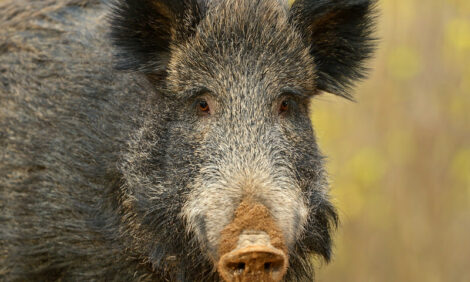



Comparison of Terminal Sire Pig Genetics Available
NORTHERN IRELAND, UK - Historically, Landrace was one of the main terminal sire breeds of slaughter generation pigs in Northern Ireland. With the onset of PMWS (Post-weaning multisystemic wasting syndrome) in Northern Ireland, Pietrain and Tempo genetics became popular choices due to their reported ability to increase the survivability of pigs in herds afflicted with PMWS.
Photo: AFBI
These terminal sire breeds are still readily available and provide Northern Ireland producers with a range of options regards terminal sire genetics. A trial conducted at the Agri-Food and Biosciences Institute, Hillsborough and co-funded by DARD, Pig ReGen Ltd and the British Pig Executive (BPEX) investigated the production and carcass performance and meat quality of pigs originating from these different sire breeds. Progeny from sires of the Tempo, Landrace, Pietrain (Austrian) and Pietrain (Belgium) breeds were compared. It should be noted that the study was limited by the number of sires used within each breed but each AI supplier was encouraged to supply the semen from their ‘best’ sires.
Pietrain Austrian litters were found to be numerically larger with one extra pig per litter born alive. However, birth weight was on average 0.14kg lighter and mortality was 10.5 per cent higher than pigs from the other sire breeds. Overall, the pre weaning average daily gain of piglets from all genetics was similar as was the number of piglets weaned and the total weight of piglets weaned per litter. Pig performance was also similar for all genetics between weaning and 10 weeks of age. However, genetics had a significant effect on finishing pig performance (Table 1). Pigs in the main study were taken to a target carcass weight of 78kg. The growth rate and feed intake of Tempo pigs during finishing was 84g per day and 80g per day, higher than that of pigs from the other sire breeds. The feed use efficiency of Tempo and Pietrain Austrian pigs was similar and better than that of Pietrain Belgium and Landrace pigs. Landrace pigs were fatter than the other pigs.
The killing out percentage of Pietrain Austrian and Belgium pigs was higher than that of the Tempo and Landrace pigs. Tempo pigs were the best at converting feed to carcass gain while Landrace pigs were the worst. Based on current feed costs and pig price, Tempo and Pietrain Austrian pigs had a similar margin over feed which was approximately £4.40 per pig more than Landrace pigs and £1.40 per pig more than Pietrain Belgium pigs. Regards meat quality, meat from Pietrain Austrian pigs had the highest drip loss and the meat was pale. On the other hand meat from the Tempo pigs had the lowest drip loss and was the darkest.

A proportion of pigs within each sire breed were sent for slaughter at either 95, 105 or 115kg live weight which corresponded to carcass weights of approximately 73, 81 and 88kg respectively. Across all sire breeds, when slaughter weight increased to 115 kg, back fat depth increased (Figure 1) but kill out percentage remained constant. However, even at these weights, the carcasses of Pietrain Austrian and Belgium and Tempo pigs would still be considered as ‘code 1’ but Landrace pigs would be penalised. In addition, as pigs got heavier, drip loss increased. Chops from pigs with a carcass weight of 73kg lost 5.7 per cent of lean weight through drip loss, chops from pigs with a carcass weight of 81kg lost 6.2 per cent and chops from pigs with a carcass weight of 88kg lost 7.1 per cent. Visible drip loss in packaging is often not acceptable by the consumer.
In conclusion, a similar margin over feed was found using the Tempo and Pietrain Austrian genetics. However, the meat quality of Pietrain Austrian pigs appeared to be poorer in terms of drip loss than that of Tempo pigs. This study also suggests that the carcass weight of Tempo and Pietrain pigs could be increased to 88kg with no detrimental effects on grading. However, increasing carcass weight appears to reduce meat quality.
Overall there is much variation between the production and carcass performance between progeny from the different sire breeds available to Northern Ireland producers. This study highlights the need for the industry to have commercially applicable information regards pig and carcass performance from different genetic sources.
| Table 1 The effect of genetics on finishing pig performance (30kg to 105kg) |
||||
| Values | Landrace | Pietrain (Austrian) |
Pietrain (Belgium) |
Tempo |
|---|---|---|---|---|
| Performance: Daily gain (g per day) |
804 | 815 | 794 | 888 |
| Performance: Daily feed intake (g per day) |
2083 | 2027 | 2006 | 2119 |
| Performance: Feed efficiency |
2.68 | 2.52 | 2.59 | 2.44 |
| Carcass performance: 'Probe' (mm) |
13.9 | 12.8 | 12.6 | 12.9 |
| Carcass performance: Killing out (%) |
75.8 | 77.4 | 77.0 | 76.1 |
| Carcass performance: Feed:carcass gain |
2.76 | 2.64 | 2.68 | 2.59 |








